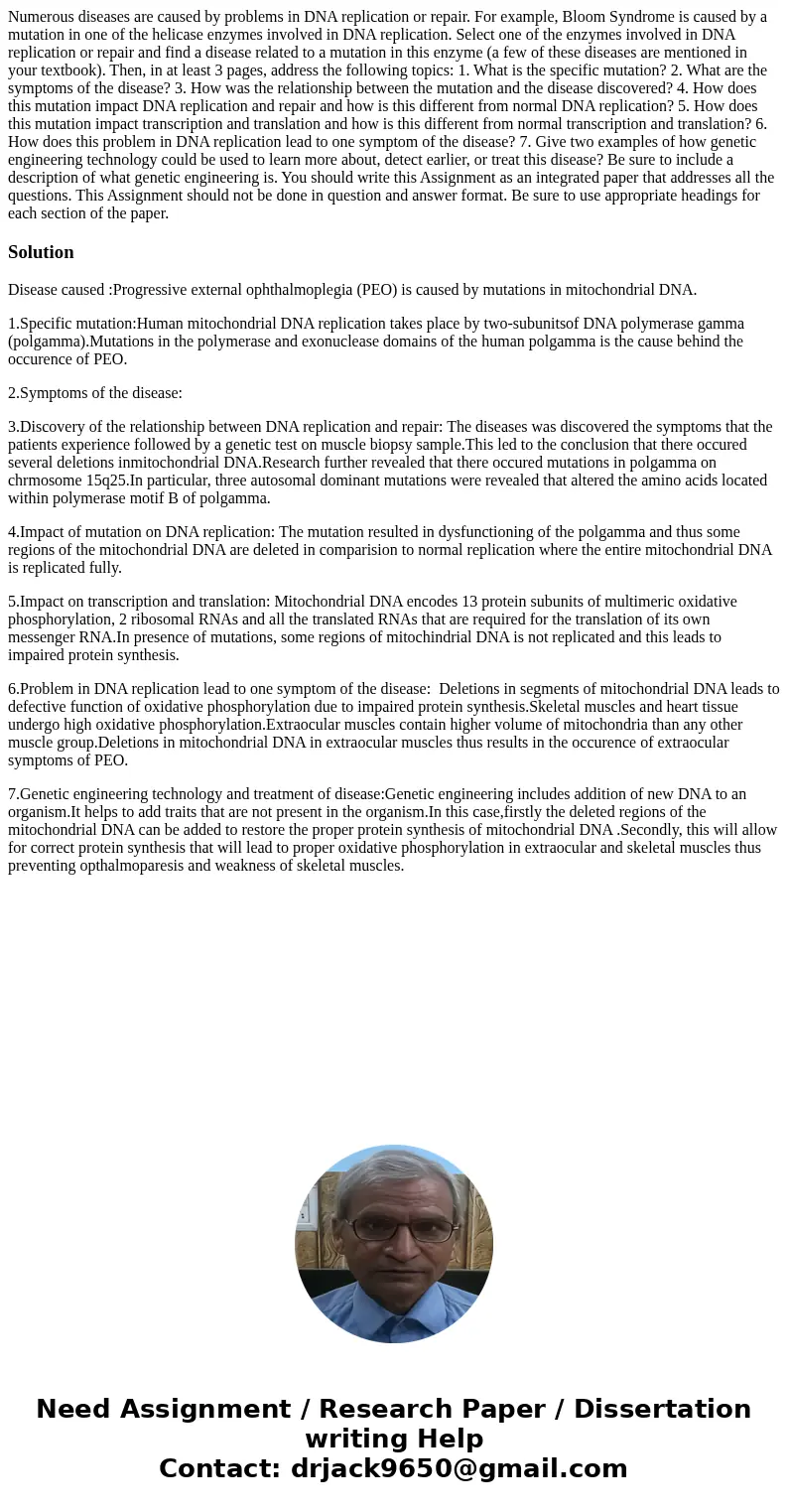Numerous diseases are caused by problems in DNA replication
Numerous diseases are caused by problems in DNA replication or repair. For example, Bloom Syndrome is caused by a mutation in one of the helicase enzymes involved in DNA replication. Select one of the enzymes involved in DNA replication or repair and find a disease related to a mutation in this enzyme (a few of these diseases are mentioned in your textbook). Then, in at least 3 pages, address the following topics: 1. What is the specific mutation? 2. What are the symptoms of the disease? 3. How was the relationship between the mutation and the disease discovered? 4. How does this mutation impact DNA replication and repair and how is this different from normal DNA replication? 5. How does this mutation impact transcription and translation and how is this different from normal transcription and translation? 6. How does this problem in DNA replication lead to one symptom of the disease? 7. Give two examples of how genetic engineering technology could be used to learn more about, detect earlier, or treat this disease? Be sure to include a description of what genetic engineering is. You should write this Assignment as an integrated paper that addresses all the questions. This Assignment should not be done in question and answer format. Be sure to use appropriate headings for each section of the paper.
Solution
Disease caused :Progressive external ophthalmoplegia (PEO) is caused by mutations in mitochondrial DNA.
1.Specific mutation:Human mitochondrial DNA replication takes place by two-subunitsof DNA polymerase gamma (polgamma).Mutations in the polymerase and exonuclease domains of the human polgamma is the cause behind the occurence of PEO.
2.Symptoms of the disease:
3.Discovery of the relationship between DNA replication and repair: The diseases was discovered the symptoms that the patients experience followed by a genetic test on muscle biopsy sample.This led to the conclusion that there occured several deletions inmitochondrial DNA.Research further revealed that there occured mutations in polgamma on chrmosome 15q25.In particular, three autosomal dominant mutations were revealed that altered the amino acids located within polymerase motif B of polgamma.
4.Impact of mutation on DNA replication: The mutation resulted in dysfunctioning of the polgamma and thus some regions of the mitochondrial DNA are deleted in comparision to normal replication where the entire mitochondrial DNA is replicated fully.
5.Impact on transcription and translation: Mitochondrial DNA encodes 13 protein subunits of multimeric oxidative phosphorylation, 2 ribosomal RNAs and all the translated RNAs that are required for the translation of its own messenger RNA.In presence of mutations, some regions of mitochindrial DNA is not replicated and this leads to impaired protein synthesis.
6.Problem in DNA replication lead to one symptom of the disease: Deletions in segments of mitochondrial DNA leads to defective function of oxidative phosphorylation due to impaired protein synthesis.Skeletal muscles and heart tissue undergo high oxidative phosphorylation.Extraocular muscles contain higher volume of mitochondria than any other muscle group.Deletions in mitochondrial DNA in extraocular muscles thus results in the occurence of extraocular symptoms of PEO.
7.Genetic engineering technology and treatment of disease:Genetic engineering includes addition of new DNA to an organism.It helps to add traits that are not present in the organism.In this case,firstly the deleted regions of the mitochondrial DNA can be added to restore the proper protein synthesis of mitochondrial DNA .Secondly, this will allow for correct protein synthesis that will lead to proper oxidative phosphorylation in extraocular and skeletal muscles thus preventing opthalmoparesis and weakness of skeletal muscles.

 Homework Sourse
Homework Sourse